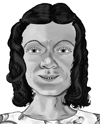Faces
| If you want to have people in your games, you gotta have faces. Early on, I decided that faces were crucial to the emotional feel of any game. The work of Susan Brennan in the graphical representation of faces convinced me that face displays were feasible in games. My first attempt in this direction was the faces in Gossip; also important was the fact that these faces were emotionally manipulable, showing different expressions. The display of a Merlin face in Excalibur was another early example. The original Balance of Power lacked faces, but this was largely because I was sweating memory consumption; with the second edition of the game, I included faces of the advisors. In Siboot I went even further, using a generic face system that permitted expression of a variety of emotions. With Guns & Butter, I took the idea even further, using a variation of Susan Brennan's face-display technology to present a variety of faces. In the unfinished game Le Morte D'Arthur, I went much further, showing a great variety of faces with a great variety of emotions. Last, in the first version of Erasmatron, I took the concept its furthest. Figures 27.1 through 27.5 shows the progression of faces that I have used over the years. 27.1. Gossip (1983).
27.5. Erasmatron Version 1 (1993).
As you can see, the faces grew bigger, more expressive, and more elaborate. 27.2. Siboot (1987).
27.3. Guns & Butter (1990).
27.4. Le Morte D'Arthur (1989).
|
EAN: 2147483647
Pages: 248
- The Four Keys to Lean Six Sigma
- Key #1: Delight Your Customers with Speed and Quality
- Beyond the Basics: The Five Laws of Lean Six Sigma
- Making Improvements That Last: An Illustrated Guide to DMAIC and the Lean Six Sigma Toolkit
- The Experience of Making Improvements: What Its Like to Work on Lean Six Sigma Projects
- PE-CE Routing Protocol-OSPF and EIGRP
- OSPF PE-CE Routing Protocol Overview, Configuration and Verification
- Command Reference
- Configuring L2TPv3 Dynamic Tunnels
- Case Study 2: Implementing Multi-VRF CE, VRF Selection Using Source IP Address, VRF Selection Using Policy-Based Routing, NAT and HSRP Support in MPLS VPN, and Multicast VPN Support over Multi-VRF CE



